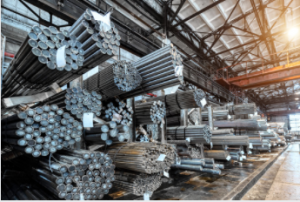Steel is a material that is made from iron. It usually contains a few tenths of a per cent carbon, which increases the strength and fracture resistance of the steel. Stainless steels also contain up to 11% chromium, which provides corrosion resistance. These metals are widely used for industrial applications, including construction and automotive parts.
 Steel’s chemical composition and recyclability are critical in deciding how to recycle steel. This research has been done with low-alloy steel, type 4130. The steel was processed using L-PBF, which uses water-atomized powder as feedstock. The study considered the effects of powder recycling and found that the chemical composition remained relatively constant. In addition, the recycled powder exhibited a slight reduction in oxygen content, although the overall composition of the steel was essentially unchanged, and the as-built steel microstructure was primarily martensitic with a high fraction of low-angle grain boundaries. These results indicate that direct tempering may be a feasible alternative to conventional quench-and-tempered treatment.
Steel’s chemical composition and recyclability are critical in deciding how to recycle steel. This research has been done with low-alloy steel, type 4130. The steel was processed using L-PBF, which uses water-atomized powder as feedstock. The study considered the effects of powder recycling and found that the chemical composition remained relatively constant. In addition, the recycled powder exhibited a slight reduction in oxygen content, although the overall composition of the steel was essentially unchanged, and the as-built steel microstructure was primarily martensitic with a high fraction of low-angle grain boundaries. These results indicate that direct tempering may be a feasible alternative to conventional quench-and-tempered treatment.
Alloys
Steel alloys are made with different elements in different amounts, typically between 1.0% and 50%, to enhance the mechanical properties of the metal. Steel alloys can be broken down into two main categories: low alloy steels and high alloy steels. However, the exact distinction between the two is contested. For now, let’s look at low alloy steels.
These steel alloys are made of carbon steel and other alloying elements. The combination of these elements affects the material’s hardness, machinability, and weldability. As a result, most of these steels require heat treatment before they are ready for use.
Chemical composition
Many everyday objects are made of steel, which is a common element. Knowing the chemical composition of steel can help you choose the right type for your needs. Steel is a complex mixture rather than a single compound, and the percentage of carbon, sulphur, and other elements will vary. The added elements and their amounts will determine the chemical composition and the final alloy’s characteristics.
There are many types of steel Adelaide, each with a unique composition. The most common type is low-carbon steel. It is softer than other types of steel. High-carbon steel is special steel with more carbon than other types, and this type is often used in tools like railway tracks and automobile bodies.
Common uses
Many household appliances, doors, and roofs are made of steel Adelaide because it’s durable and reliable. Steel is also used in water pipes because it doesn’t rust and can withstand heavy loads. Water and sanitation companies have been using steel for over 150 years. Steel is used in many industrial settings as well.
Steel wires are used in many industrial applications, including the transportation industry. Wires made of steel can support people and lift heavy objects. Wire ropes are also commonly used in production. They move heavy loads, position equipment, and supply parts. Steel wires are essential to many automotive parts. But not all steel wires are made the same.
Steel buildings have many uses, ranging from small garages to massive warehouses. The most popular use for metal buildings is in the construction industry. They can be detached from homes or attached to other buildings. Businesses often use them to store equipment, park cars and even work on projects.
Recyclability
The recyclability of steel is an essential concept in sustainable construction. It is vital because reusing materials is a way to increase the economic and environmental value of a product. Steel, widely used in construction, is a highly sustainable building material that can be reused repeatedly without losing strength.
Unlike plastic, which must be downcycled to be recycled again, steel is capable of continuous recycling. As a result, steel construction components are increasingly being designed for reuse.
Steel is one of the most recyclable materials on earth. It is because steel is magnetic, which allows it to separate easily from other metals. Additionally, the process of recycling steel does not degrade the material. It means that the remelted steel does not lose its strength or value. As a result, it is an ideal choice for recycling.
Production
The global steel industry has grown rapidly recently, with flows rising eightfold between 1995 and 2015. However, operating production capacity in low carbon-intensive regions has declined.
Another approach to steel production is to reduce energy use and environmental impact through design and planning. This approach reduces energy costs by using more efficient processes. The first step is to identify an optimal 24 h production schedule that can meet the needs of a steel company. This approach uses an energy-aware scheduling model with intermediate buffers to make the production network more efficient.
